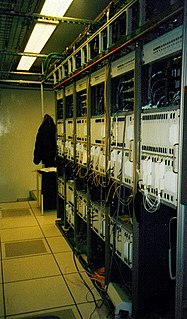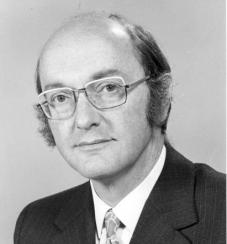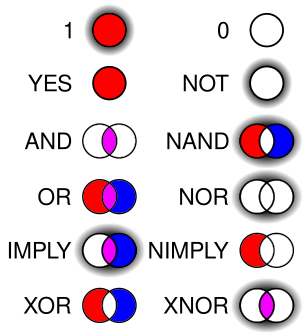
In theoretical network science, the Turing switch is a logical construction modeling the operation of the network switch, just as in theoretical computer science a Turing machine models the operation of a computer. Both are named in honor of the English logician Alan Turing, although the research in Turing switches is not based on Turing's research. Some introductory research on the Turing switch was started at the University of Cambridge by Jon Crowcroft (Homepage).

Network science is an academic field which studies complex networks such as telecommunication networks, computer networks, biological networks, cognitive and semantic networks, and social networks, considering distinct elements or actors represented by nodes and the connections between the elements or actors as links. The field draws on theories and methods including graph theory from mathematics, statistical mechanics from physics, data mining and information visualization from computer science, inferential modeling from statistics, and social structure from sociology. The United States National Research Council defines network science as "the study of network representations of physical, biological, and social phenomena leading to predictive models of these phenomena."
A network switch is a computer networking device that connects devices on a computer network by using packet switching to receive, process, and forward data to the destination device.

Theoretical computer science (TCS) is a subset of general computer science and mathematics that focuses on more mathematical topics of computing and includes the theory of computation.
In essence, Crowcroft suggests that instead of using general-purpose computers to do packet switching, the required operations should be reduced to application specific logic and then that application specific logic should be implemented using optical components. The work is not actually based on Turing's research.

Packet switching is a method of grouping data that is transmitted over a digital network into packets. Packets are made of a header and a payload. Data in the header are used by networking hardware to direct the packet to its destination where the payload is extracted and used by application software. Packet switching is the primary basis for data communications in computer networks worldwide.
Optical networking is a means of communication that uses signals encoded onto light to transmit information among various nodes of a telecommunications network. They operate from the limited range of a local-area network (LAN) or over a wide-area network (WAN), which can cross metropolitan and regional areas all the way to national, international and transoceanic distances. It is a form of optical communication that relies on optical amplifiers, lasers or LEDs and wave division multiplexing (WDM) to transmit large quantities of data, generally across fiber-optic cables. Because it is capable of achieving extremely high bandwidth, it is an enabling technology for today’s Internet and the communication networks that transmit the vast majority of all human and machine-to-machine information.
A Turing switch consists of a switched fabric, one or more ingress interfaces (also referred to as sources), one or more egress interfaces (sinks), and a decision procedure to determine an egress interface given an ingress interface. Interfaces are sometimes referred to as ports. A packet (cell or switched unit) arrives at an ingress interface, the appropriate egress interface is determined by the decision procedure, and the packet is then transported across the switching fabric to the egress interface. A packet is a symbol or sequence of 1's and 0's. An ingress interface is connected to an ingress line and an egress interface to an egress line. The ingress line is said to feed the ingress interface; the egress interface feeds the egress line. [1]
Switched Fabric or switching fabric is a network topology in which network nodes interconnect via one or more network switches. Because a switched fabric network spreads network traffic across multiple physical links, it yields higher total throughput than broadcast networks, such as the early 10BASE5 version of Ethernet, or most wireless networks such as Wi-Fi.








